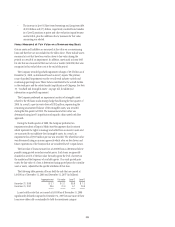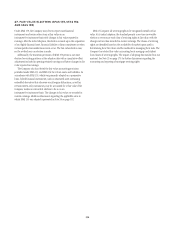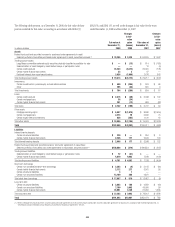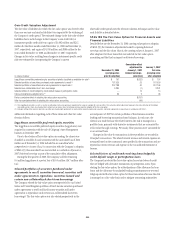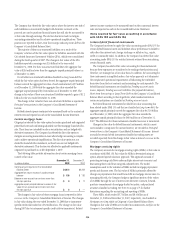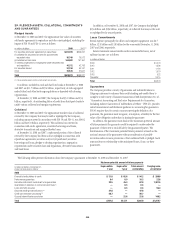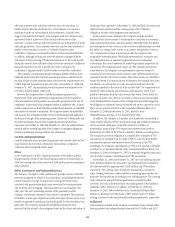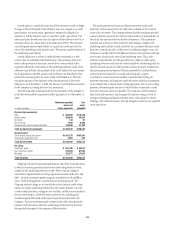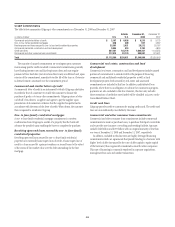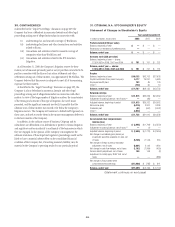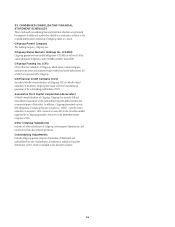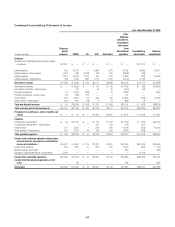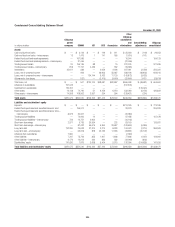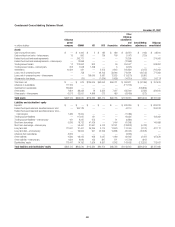Citibank 2008 Annual Report Download - page 217
Download and view the complete annual report
Please find page 217 of the 2008 Citibank annual report below. You can navigate through the pages in the report by either clicking on the pages listed below, or by using the keyword search tool below to find specific information within the annual report.
billion at December 31, 2008 and December 31, 2007, respectively. Securities
and other marketable assets held as collateral amounted to $27 billion and
$54 billion, the majority of which collateral is held to reimburse losses
realized under securities lending indemnifications. The decrease from the
prior year is in line with the decrease in the notional amount of these
indemnifications, which are collateralized. Additionally, letters of credit in
favor of the Company held as collateral amounted to $503 million and $370
million at December 31, 2008 and December 31, 2007, respectively. Other
property may also be available to the Company to cover losses under certain
guarantees and indemnifications; however, the value of such property has
not been determined.
Performance Risk
Citigroup evaluates the performance risk of its guarantees based on the
assigned referenced counterparty internal or external ratings. Where external
ratings are used, investment-grade ratings are considered to be Baa/BBB and
above, while anything below is considered non-investment grade. The
Citigroup internal ratings are in line with the related external rating system.
On certain underlying referenced credits or entities, ratings are not available.
Such referenced credits are included in the “Not-rated” category. The
maximum potential amount of the future payments related to guarantees
and credit derivatives sold is determined to be the notional amount of these
contracts, which is the par amount of the assets guaranteed.
Presented in the table below is the maximum potential amount of future
payments classified based upon internal and external credit ratings as of
December 31, 2008. As previously mentioned, the determination of the
maximum potential future payments is based on the notional amount of the
guarantees without consideration of possible recoveries under recourse
provisions or from collateral held or pledged. Such amounts bear no
relationship to the anticipated losses, if any, on these guarantees.
Maximum potential amount of future payments
In billions of dollars
Investment
grade
Non-investment
grade
Not
rated Total
Financial standby letters of
credit $49.2 $28.6 $ 16.4 $ 94.2
Performance guarantees 5.7 5.0 5.6 16.3
Derivative instruments
deemed to be
guarantees — — 67.9 67.9
Guarantees of collection of
contractual cash flows — — 0.3 0.3
Loans sold with recourse — — 0.3 0.3
Securities lending
indemnifications — — 47.6 47.6
Credit card merchant
processing — — 56.7 56.7
Custody indemnifications
and other 18.5 3.1 — 21.6
Total $73.4 $36.7 $194.8 $304.9
Credit Derivatives
A credit derivative is a bilateral contract between a buyer and a seller under
which the seller sells protection against the credit risk of a particular entity
(“reference entity” or “reference credit”). Credit derivatives generally require
that the seller of credit protection make payments to the buyer upon the
occurrence of predefined credit events (commonly referred to as “settlement
triggers”). These settlement triggers are defined by the form of the derivative
and the reference credit and are generally limited to the market standard of
failure to pay on indebtedness and bankruptcy of the reference credit and, in
a more limited range of transactions, debt restructuring. Credit derivative
transactions referring to emerging market reference credits will also typically
include additional settlement triggers to cover the acceleration of
indebtedness and the risk of repudiation or a payment moratorium. In
certain transactions, protection may be provided on a portfolio of referenced
credits or asset-backed securities. The seller of such protection may not be
required to make payment until a specified amount of losses has occurred
with respect to the portfolio and/or may only be required to pay for losses up
to a specified amount.
The Company makes markets in and trades a range of credit derivatives,
both on behalf of clients as well as for its own account. Through these
contracts, the Company either purchases or writes protection on either a
single name or a portfolio of reference credits. The Company uses credit
derivatives to help mitigate credit risk in its corporate loan portfolio and
other cash positions, to take proprietary trading positions, and to facilitate
client transactions.
The range of credit derivatives sold includes credit default swaps, total
return swaps and credit options.
A credit default swap is a contract in which, for a fee, a protection seller
(guarantor) agrees to reimburse a protection buyer (beneficiary) for any
losses that occur due to a credit event on a reference entity. If there is no
credit default event or settlement trigger, as defined by the specific derivative
contract, then the guarantor makes no payments to the beneficiary and
receives only the contractually specified fee. However, if a credit event occurs
and in accordance with the specific derivative contract sold, the guarantor
will be required to make a payment to the beneficiary.
A total return swap transfers the total economic performance of a
reference asset, which includes all associated cash flows, as well as capital
appreciation or depreciation. The protection buyer (beneficiary) receives a
floating rate of interest and any depreciation on the reference asset from the
protection seller (guarantor), and in return the protection seller receives the
cash flows associated with the reference asset, plus any appreciation. Thus,
the beneficiary will be obligated to make a payment any time the floating
interest rate payment according to the total return swap agreement and any
depreciation of the reference asset exceed the cash flows associated with the
underlying asset. A total return swap may terminate upon a default of the
reference asset subject to the provisions in the related total return swap
agreement between the protection seller (guarantor) and the protection
buyer (beneficiary).
211


